Paper Doll Refreshes Your Paper Organizing Solutions
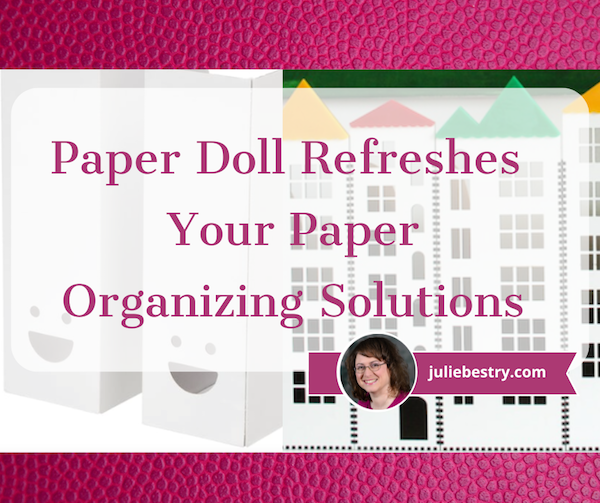
Springtime gives us an opportunity to refresh how we do what we do. Today, we’re going to give some new thought to our obstacles and strategies for keeping our papers organized, and then take a peek at opposite ends of the spectrum for paper storage solutions: one fun and one seriously sturdy.
REFRESHING YOUR PAPER PROCESSES
My friend and professional organizing colleague Yve Irish in Rochester, New York recently asked me if I’d like to write a guest post for her blog.

We’re in the same Mastermind group, and we’re often talking about how we can help support one another’s businesses, and this seemed like a fun opportunity. It made sense for me to talk about my favorite topic — paper!
How To Make Paper Less Overwhelming
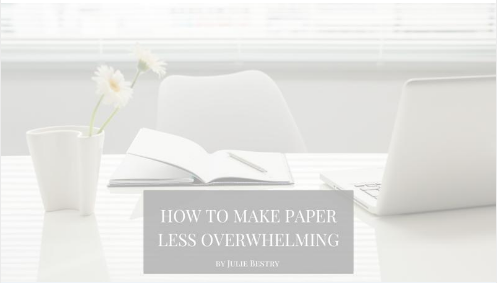
In that post (which is much shorter than the typical Paper Doll post, so you might not need a sandwich to sustain you as you read it), I cover:
- Why it’s so difficult and frustrating to keep paper organized
- The difference between action papers and reference papers
- How to break your files down into clear categories so that you can quickly file them and easily access them again when you need a specific document
- Secrets for success when trying to get — and keep — your papers in order.
I invite you to read the post and visit the rest of Yve’s blog at your convenience. Tell Yve I said “Hi!”
MAKE YOUR SPACE HAPPY WITH MAGAZINE FILES
Most of the time, when we talk about keeping paper organized, we focus on using files folders. (In the guest post above, I even explain why file folders are usually preferable to three-ring binders.) But there are definitely other paper storage solutions, depending on the types of paper we’re talking about.
For example, if the paper is teeny-tiny, like an index card, there are a variety of appropriate storage options, such as I discussed in The Humble Index Card: Organize Your Life, Then Organize Your Cards.
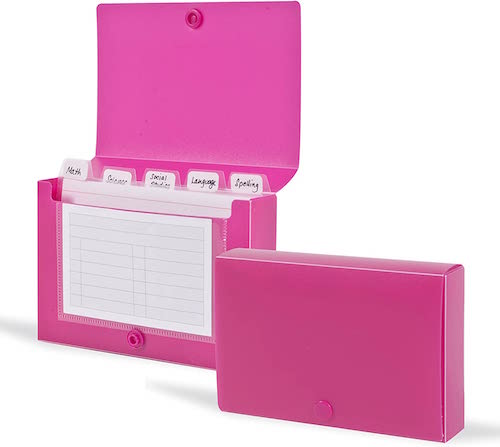
Similarly, although we don’t discuss them often, there are a variety of uses for magazine files. For example, you can use them to store:
- Magazines — Duh! But don’t keep all of your magazines forever, or the foundation of your house will buckle. Instead, magazine files are great for maintaining the most recent month of your subscriptions. When the new ones arrive, you can sub them in for last month’s issue. Magazine files are also useful for keeping oft-referenced magazine issues on a particular topic, such as holiday issues for recipes (though I’d still suggest creating your own recipe file system, as I suggested in Calm Cooking Chaos (Part 1): Organize Your Paper Recipes).
- Store Catalogs — If you like ordering from catalogs, or just have fun flipping through them and dreaming about what you might buy, neatly stashing catalogs in a magazine file keeps them tidy and accessible. Do note, however, that almost all catalogs have the same items in them month and after month, just with different layouts and updated pricing, so there’s no need to keep old catalogs once the new ones arrive.
- Travel Brochures, Maps, and City Guides — Although I’m not ready to get back on airplanes (which felt like germy tin cans even before COVID), I had so much fun on my Smithsonian tours of Italy (2018) and the UK (2019) that I keep the most recent Smithsonian Journeys catalog of trip options so that I can refresh my inner aspirational traveler. You might like to keep a magazine file of local city guides on a side table in your guest room to help overnight visitors consider where they might like to dine or travel.
- Instruction Manuals — For simple manuals, a file folder works fine, but depending on how many manuals you keep, and the sizes of them, or if you’re short on filing space, you might want to maintain a bookshelf of matching magazine files. Consider separate magazines files for different categories, such as:
- Major household appliances (water heater, refrigerator, washer/dryer, electric garage door)
- Kitchen appliances (air fryer, food processor, bread maker, microwave)
- Home theater electronics (televisions, stereos, DVRs)
- Computer hardware and software (including peripherals like printers and scanners)
- Communication devices (phones, digital assistants like Home Pod or Alexa)
- Personal electronics (smart watches, ebook readers, pedometers, heart rate monitors)
- Specialty manuals (exercise equipment, home medical equipment)
- College Catalogs — Once your kids start taking the PSATs and other pre-college tests, they will receive a shocking number of catalogs for colleges and universities in far-flung places. (A few years ago, I went back to my childhood home and found that my teenage closet was still filled with multiple paper grocery sacks of college catalogs circa 1984-1985, and I would not be hyperbolic in stating that at least 20% were, mystifyingly, from Valparaiso University in Indiana.) Try to keep only the catalogs for schools to which they’re likely to apply (and not your dream schools).
- Phone/Address Directories — We rarely see old-style phonebooks, the ones suitable as booster seats for toddlers. Many communities no longer have “white pages,” at all, and where “yellow pages” exist, they’re often about the thickness of a magazine. Church and school directories are often only available online. But if you do have bound directories, keeping them all together in a magazine file makes it handy when you need to make a call.
- Takeout/Delivery Menus — You probably use your phone to order delivery or get takeout. But new restaurants will still stick their menus under your windshield or between your screen door and front door, so whether you want them or not, you’ve probably got a pile of them. Don’t just stack them on the microwave or stick them in a kitchen drawer — but do keep them if the food appeals to you. When Paper Mommy, my sister, and I are together in my sister’s city, we often have to juggle phones to plan food delivery. My sister has an Android, so she can’t Airdrop a menu to the two of us (Apple users); instead, she tells me the name/URL of the restaurant, and I look it up and then Airdrop it from my phone to my mother’s iPad. It’s a whole process even before we start figuring out what we want to order. Having a takeout menu collection might make it much easier. Just plop the ones from which you’re likely to order in a magazine file.
I recently found a few intriguing magazine files.
First, Ikea’s TJABBA (a variation on their only-slightly pricier but less adorable TJENA magazine file) is currently on sale for only 99 cents/2 pack, so I suspect it won’t be around long, but it’s so cute!
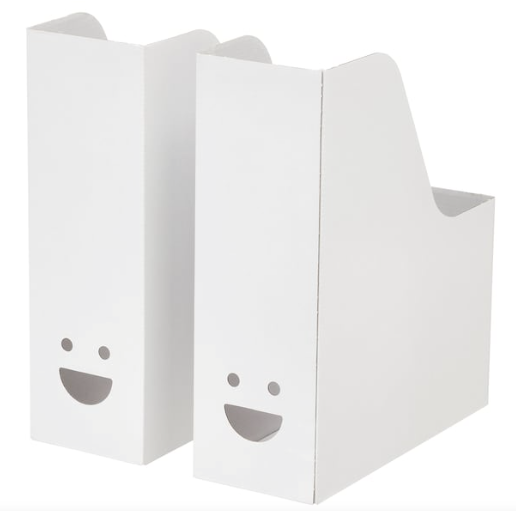
The smiley face design is made by adding two tiny punch-out circles above the open space used to pull the file off of the shelf. You get a sneak peek of the contents but still get to keep the “messy” side of the magazine file toward the wall.
The TJABBA files are easy to assemble and can collapse and fold up to save space if you don’t need them for a while. They measure 9 3/4″ deep, 11 3/4″ high, and 4″ wide.
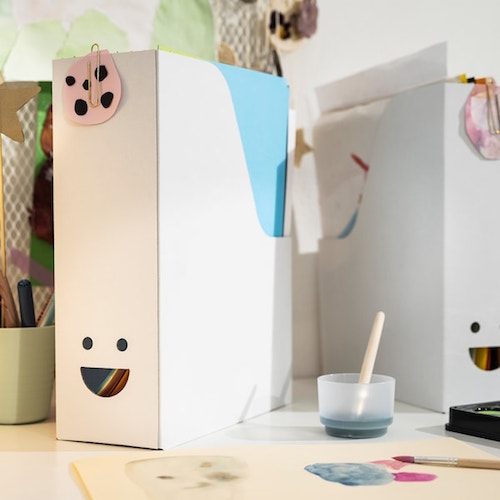
If you prefer to support independent small businesses and don’t mind waiting a little extra time for shipping, the Bluble shop on Etsy has magazine files designed to look like townhouses. They’re handmade of “woodlike” (or solid color) laminated high density fibreboard.
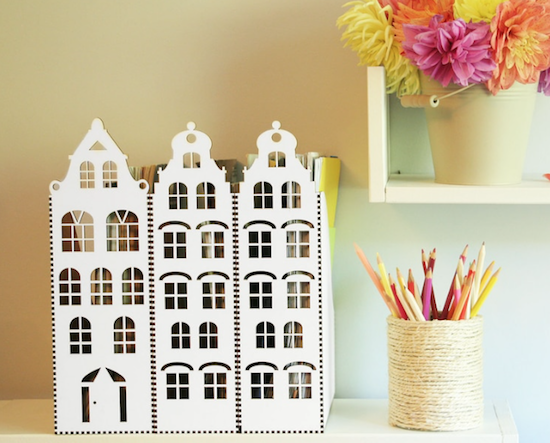
There are three styles of these magazine files:
# 1 measures 34.7 cm high, 11.0 cm wide, and 23 cm deep
# 2 measures 34.3 cm high, 9.3 cm wide, and 23 cm deep
# 3 measures 34.5 cm high, 8.0 cm wide, and 23 cm deep
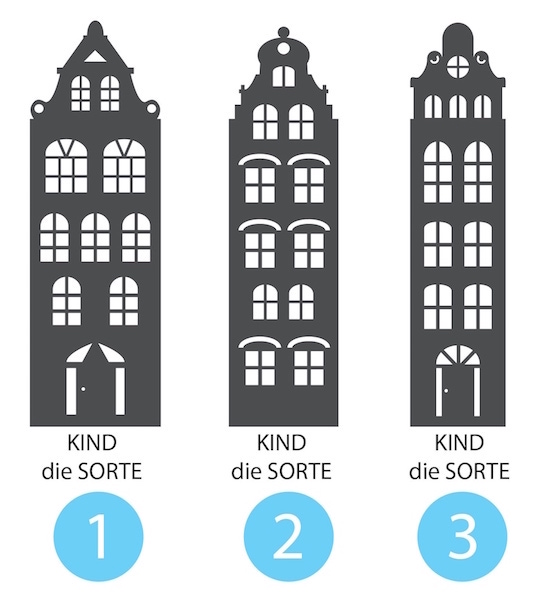
You can select any of the three styles in a variety of colors, depending on what kind of cityscape you’d like to create on your shelf. The options are maple, oak, pine, cherry, apple, nut, “wenge” (sort of darker brown), black, grey, and white.
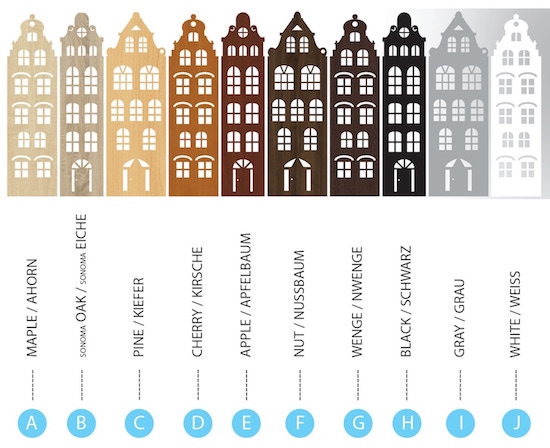
These Bluble storage solutions are $5.70/each, which seems incredibly reasonable for a hand-made townhouse-style magazine file, but Etsy calculated that shipping from Germany to my own zip code would be $28, so this might be better if you are planning on buying many of them for practical décor and not just to hide in a cabinet.
If you order, be prepared to state the number for the type you prefer along with the letter for the finish you want. (I’m fond of the wider townhouse #1 in pine or white, but you could mix-and-match to create your own cityscape).
Bluble also makes a version of these townhouse magazine files with different window and door stylings and colored rooftops. The color options are navy blue, blue, light blue, mint, green, light green, black, violet, red, orange, and yellow. These magazine files run $6.23/each.
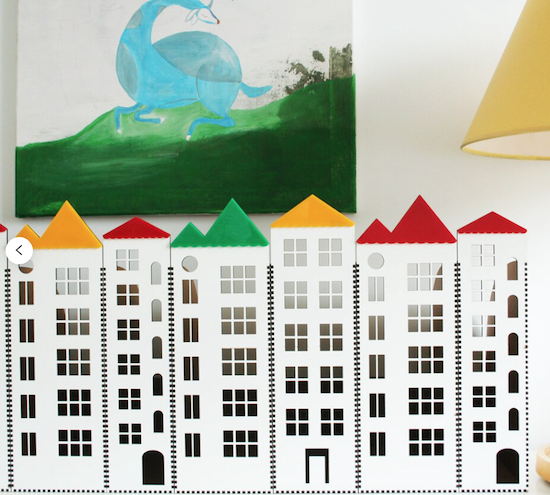
SOLVE STORAGE FOR A TON OF PAPER
It can be really annoying when you have a lot of paper that you need to store, but there are a variety of solutions depending on whether you have a little bit of a lot of paper or a whole lot of a lot paper.
Traditional (manilla) file folders are scored on the bottom (near the crease), so with a little bit of effort, the bottom of the folder can go from a sharp fold to a boxy-bottom, but that can only help add contents for so long. Plus, if you increase the bottom surface area of your file folder by folding it at the creases, fewer folders will fit in a traditional hanging folder, and eventually, that’s going to present a challenge.
Box-bottom hanging folders and expandable files are the traditional solution, and you can generally find them in sizes that providing expanding room for one-to-four inches of paper storage space, but they’re not particularly attractive.
Recently, I came across a product from our friends at Smead, a 3.5″ Hanging File Pocket with an interesting design.
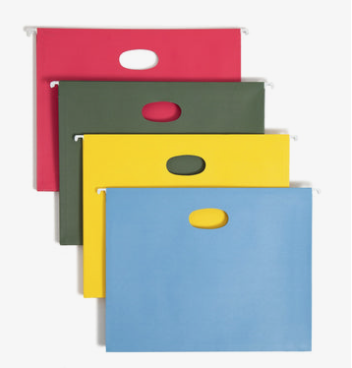
Smead 3.5″ Letter-Sized Hanging File Pockets
Suitable for collections of lots of bulky documents that you need to both hang and transport, the 3.5″ Hanging File Pocket is strong enough to expand to 3 1/2″ and has oval die-cut handles to make it easier to lift and transport a large collection of papers.
These 3.5″ Hanging File Pockets have full-height gussets (reinforced accordion-like sides rather than the typical open-sides you find with hanging folders). The gussets ensure that the paper contents of the pockets will stay secure and won’t get stuck on the file rails when the pocket is removed from a file drawer.
While the accordion style sides will expand to up to 3 1/2 inches, they take up minimal space until/unless the expansion for extra capacity is needed. For example, if you’re putting in documents for one fiscal quarter, no expansion is necessary, but as you add more paper for additional fiscal quarters, more expansion can occur.
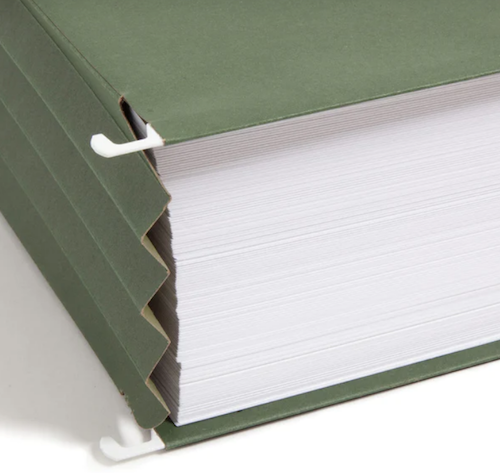
The Hanging File Pockets come in two sizes:
- Letter-sized are 11-3/4″ wide by 9-1/4″ high, not counting the hanging rods, which add an additional inch (total) of width
- Legal-sized are 14-3/4″ wide by 9-1/4″ high, not counting the hanging rods, which add an additional inch (total) of width
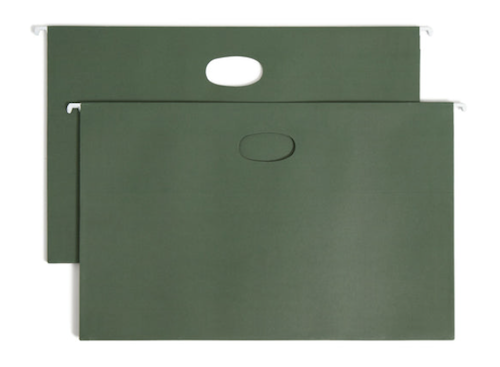
Smead 3.5″ Legal-Sized Hanging File Pockets
The letter-sized file pockets come in standard green or multi-color (red, green, yellow, and blue); the legal-sized version are only available in standard green.
(Boo! I wish someone at Smead or any of the other file supply companies could tell us whether green hanging folders and jackets are somehow less expensive to produce. Like, is Army Green a less expensive coloring agent? Why are filing solutions in pretty colors almost always more expensive?)
I should note, these Hanging File Pockets are priced for corporate use for lawyers, accountants, and people who wear serious suits each day. The pockets, and specifically the die-cut ovals that make these heavy-duty hanging file pockets so appealing, aren’t really designed for residential or home office use, the assumption being that the average person or small business isn’t going to need to keep an entire ream of paper in one folder or pocket.
The pricing is:
- $38.50 for four of the letter sized, multi-color (red, green, yellow, and blue) 3.5″ hanging file pockets (Yes. Almost $40 for four hanging pockets!)
- $75.33 for ten of the letter-sized, standard green 3.5″ hanging file pockets
- $83.61 for ten of the legal-sized, standard green 3.5″ hanging file pockets
- There is no option for the multi-color hanging file pockets in a legal size
These 3.5″ Hanging Pocket are only available directly from Smead.
Happy Spring from Paper Doll HQ, and please let me know if you spot any fanciful or fun paper storage solutions in the wild and I’ll be happy to credit you in a future post.




Thank you for suggesting decorating the magazine holders. I just came back from St John’s Newfoundland and they have colourful houses called Jelly bean houses. I often remind clients that magazine holders can be standing or laid on the long edge.
Laying on the long edge is an interesting approach, approximating flat file drawers. And now I want to check out the Jelly Bean houses! Thank you for sharing!
I’m in love with the ones that look like houses. How cute would those be on a shelf? Totally like “art.” (You can see I’m not much of an art expert!)
In general, I try to circulate paper on through as much as I can, but there definitely are times when we need to hold onto some. I’m working with an older gentleman now who has paper but nowhere to put it. We’re working on options!
You sound like an expert to me; art is exactly how I see this. (Hence my “practical décor) comment. Yes, excess paper should be tossed, but for most people, getting rid of it (either through total purging or even scanning) is pretty much a non-starter. So finding storage options is definitely key!
I’m a HUGE fan of magazine holders for catalogs, magazines, paper management systems, and projects. They are easy to categorize, easy to file and retrieve, and visually appealing. I LOVE those wooden house boxes! How fun! I also love the Bigso Stockholm magazine holders from The Container Store. They’re durable, decorative, and come in many colors.
I knew about their flat file boxes (that are like little drawers) so now I’m off to check out the Bigso Stockholm magazine holders!
The only issue with magazine holders is having adequate height; on a table, counter, or desk, there’s no issue, but of course, on shelves there needs to be enough “head room” (or, “rooftop” room in the case of the Bluble magazine files).
Thanks for reading and sharing!
You are speaking my language! Many manuals are online now, so keeping them is not necessary. My husband and I recently embarked on a manufacturer’s appliance manual PDF journey and now have the most recent manuals online stored in the cloud. It’s wonderful. We still have paper manuals organized in a filing cabinet by the manufacturer’s name in ABC order. However, these paper files are significantly less than they used to be. Thanks for sharing your wisdom. =)
You’re so right; I’ve blogged about on online manuals, but not since 2017, so it might be time to refresh that. But when people do have paper manuals and don’t have file space (as is often the case for my senior clients), magazine files are another useful option.
How funny to see my picture at the top of one of your blog post. 🙂
Thank you again for your wonderful guest blog – and making it part of your post today! I love how you introduce us to such neat products in so many of your posts.
Surprise! And thank you for your kind words. I hope this post introduces a lot of readers to your blog, Yve!
Hello Yve and Julie!
Terrific info and thanks for the chuckle [on your guest post] Such a quotable quote: “Your filing cabinet is not a self-cleaning oven” ?
LOL! I’m really glad you liked that, Geralin! Knowing a gave you a chuckle brings joy to my heart. 😉
I’ve always loved magazine holders for all kinds of paper…but also, high quality, shallow, flat trays work for a lot of my clients (those who pile). I know, I know, we all think piling is not a great idea, but for temporary kinds of paper like bills, notices, etc. it can be an amazing solution. Less barrier to putting things into broad categories, and easy to dump in the recycle bin when things are no longer relevant. I’m also a fan of very small filing boxes (like the Bigso ones at the Container Store) for temporary paper. Easy to place on the desk for quick access. Anyway, enough of my ideas – this is a fantastic post, as always Julie!
Yes! Flat trays are great for pilers, but “temporary” paper is that odd category that often doesn’t fit either action or reference. It’s great if you’re holding onto something while waiting to hear back that a certified letter was signed for or a refund has been processed. Those are the papers that become irrelevant without our action and without our need to save for reference. Maybe I should write a post on weird categories of paper?
Love the townhouse magazine files! Makes me think there could be any number of clever ways to dress up “magazine holders” (which, like you point out, can be used for any number of things besides magazines). Like big fat, colorful pencils on files for an elementary classroom. Or big fat Ticonderoga pencils for a writer’s office. Or an image resembling a strip of negatives for a photography studio. Or images that indicate what’s inside if you do use them for menus or maps or instruction manuals. (Granted the reason we usually see solid colors or prints is to hide them, not to emphasize them, but in certain situations it could be cute or useful.)
Ooooh, I think you’ve got a great idea, Hazel. Maybe YOU should write a blog post about this? I’m not much (or any kind of) a designer, but perhaps you could make this your next career? High-end designer magazine files!